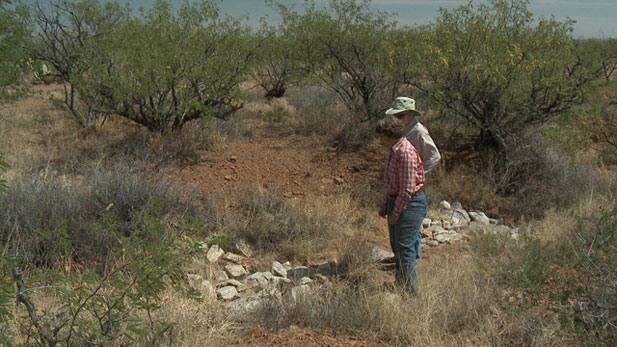 We visit Altar Valley west of Tucson where various members from the community and different agencies have created the "Altar Valley Conservation Alliance" to try to protect the land for future generations while allowing ranchers and others to continue to make a living on it.
We visit Altar Valley west of Tucson where various members from the community and different agencies have created the "Altar Valley Conservation Alliance" to try to protect the land for future generations while allowing ranchers and others to continue to make a living on it.Over 30 miles south of Tucson, is the Altar Valley Watershed. The wash which drains the eastern slopes of the Baboquivari Mountains and the western slopes of the Sierrita Mountains, is known to affect nearby residents with sheetflow flooding within its floodplain.
According to the Pima County Regional Flood Control District, the main stem of the wash has experienced severe erosion, posing an ongoing threat of lateral migration.
This watershed, which is made up of 55,404 acres of county-regulated riparian habitat, will see a reduction in downstream flood impacts thanks to federal funding from the Biden-Harris Administration’s Investing in America Agenda.
The flood control district in partnership with the Altar Valley Conservation Alliance, a rancher-led conservation group, will receive $1,213,809 through the Bureau of Reclamation (Reclamation) to enhance drought resilience in the Altar Valley Watershed.
Sarah King, executive director for the alliance, said the project is the result of decades of community collaboration throughout the 600,000-acre watershed.
“The main focus of the project is to slow down water within the project area and work on erosion control and so by slowing down water that helps soil and sediment deposit on the landscape and makes it a more stable landscape and less prone to flash floods,” King said.
Brian Jones, floodplain administrator with the county flood control district said the district will be providing a matching fund through projects.
“We’re spending the district’s dollars to do work on public lands and the Altar Valley group is going to be spending the grant dollars on private lands,” Jones said.
The project looks to install “low-tech natural infrastructure” across 8,985 acres of the wash to slow runoff, reduce erosion, and retain water as well as improve groundwater infiltration.
Jones said roads in rural landscapes often have unintended consequences for floodwaters and flowing water over the land, causing roads to become washes.
“Likely that one of the [projects] that we’ll be doing is altering the condition of the current roads that are out there so that natural flow is restored,” Jones said.
Funding also aims to increase the sustainability of agricultural operations by improving ranch land, making it more sustainable for cattle operations.
Mary Carlson with Reclamation said all projects that are being considered for funding are required to comply with all federal environmental resource requirements including the National Environmental Policy Act (NEPA), Endangered Species Act (ESA), Clean Water Act (CWA), and the National Historic Preservation Act (NHPA).
“Reclamation will act as the lead agency for completion of environmental and cultural resource compliance and must provide approval prior to project implementation moving forward,” Carlson said.
Although compliance timelines for projects vary, the Altar Valley project recipients are hopeful to receive funding by March 2024.
The Department of the Interior announced a total of $51 million in funding for 30 new Environmental Water Resource Projects in 11 states that focus on water management, conservation and restoration and watershed health.
Through the Bipartisan Infrastructure law, the Bureau of Reclamation will invest over $8 million over five years for water infrastructure projects.
So far, it has funded 372 projects with a total impact of nearly $3 million.

By submitting your comments, you hereby give AZPM the right to post your comments and potentially use them in any other form of media operated by this institution.